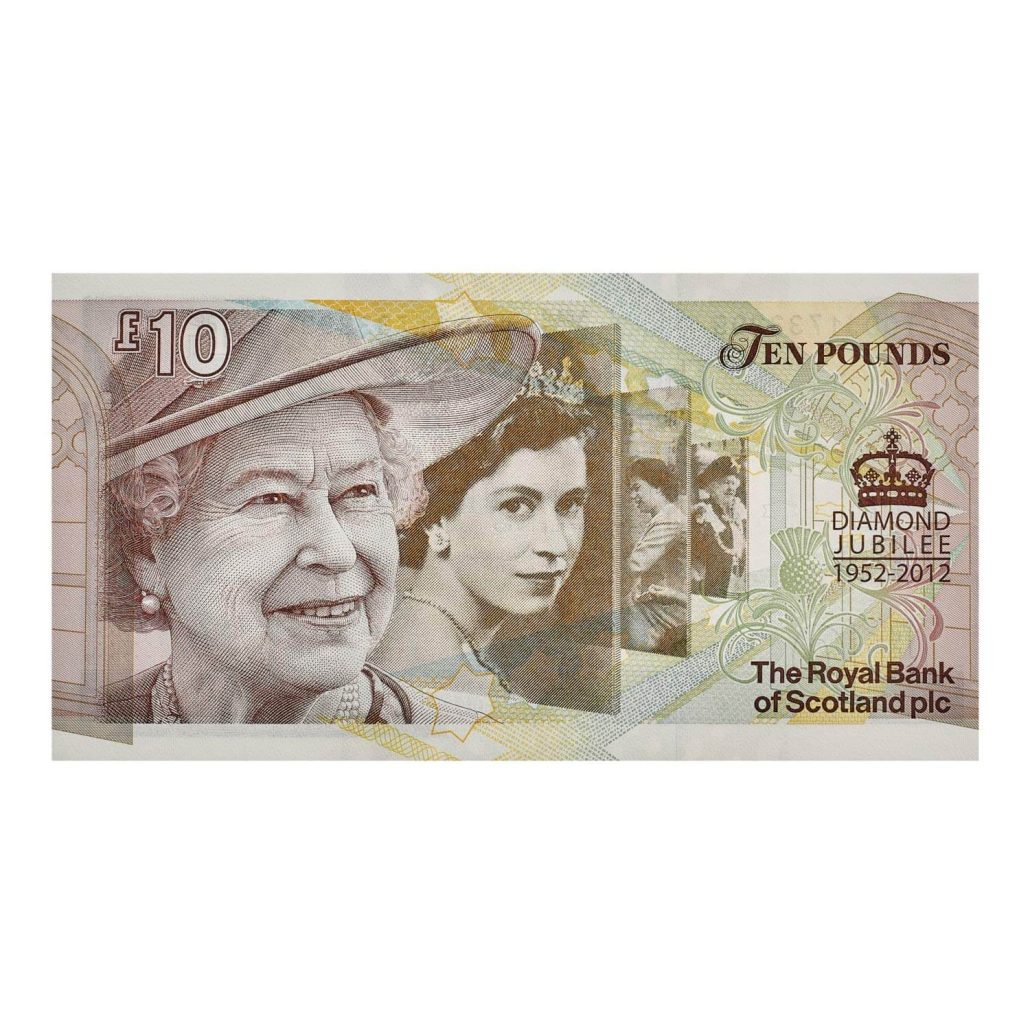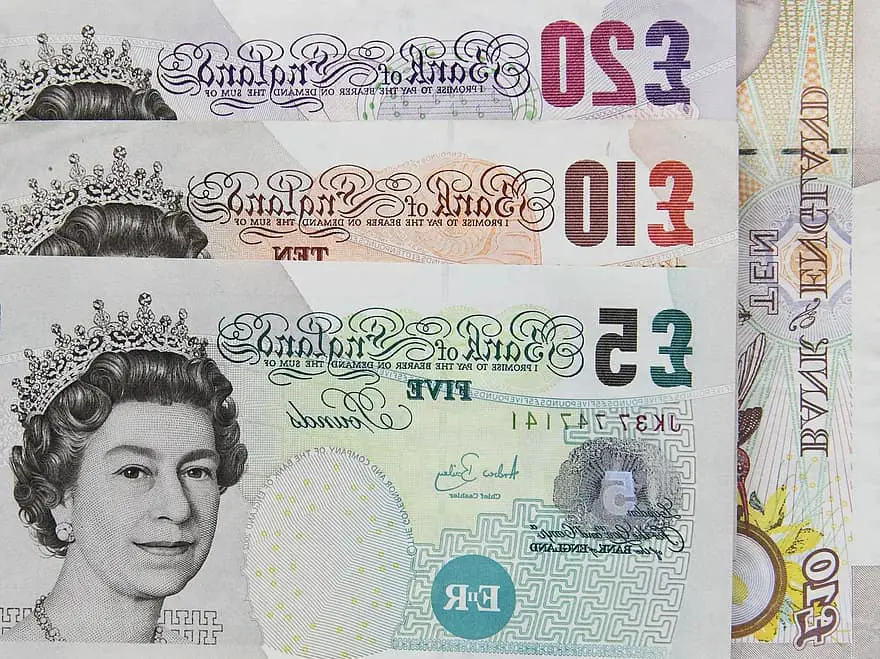The Scotland £10 Diamond Jubilee Banknote, issued by the Royal Bank of Scotland in 2012, commemorates the Diamond Jubilee of Queen Elizabeth II’s reign. This uncirculated banknote features a portrait of Lord Ilay, the Bank’s first governor, and the Queen at various stages of her life.
The banknote’s design incorporates intricate security features and holds historical significance, making it a sought-after collectible item for enthusiasts. This article delves into the issuance, design elements, security features, and valuation of the Scotland £10 Diamond Jubilee Banknote.
Issuance and Design
The Scotland £10 Diamond Jubilee Banknote, issued in 2012, holds a unique place in the history of British currency. With a denomination of £10, this commemorative note is composed of paper [1] and boasts several distinctive design elements:
- Obverse: Featuring a portrait of Lord Ilay, the first Governor of The Royal Bank of Scotland, along with the inscription “THE ROYAL BANK OF SCOTLAND plc PROMISE TO PAY THE BEARER ON DEMAND TEN POUNDS STERLING AT THEIR HEAD OFFICE HERE IN EDINBURGH BY ORDER OF THE BOARD DIAMOND JUBILEE 1952-2012 LORD ILAY FIRST GOVERNOR” [1].
- Reverse: Showcasing four images of Queen Elizabeth II at various stages of her life, accompanied by the inscription “TEN POUNDS DIAMOND JUBILEE 1952-2012 THE ROYAL BANK OF SCOTLAND plc” [1].
A significant aspect of this banknote is its limited print run of 2 million [6], making it a coveted item for collectors. Additionally, it features a special prefix ‘TQDJ’ (The Queen’s Diamond Jubilee) on the front [2], further enhancing its uniqueness.
| Design Element | Description |
|---|---|
| Obverse Portrait | Lord Ilay, the first Governor of the Royal Bank of Scotland [2] |
| Reverse Imagery | The Queen at various stages of her life [2] |
| Special Prefix | ‘TQDJ’ (The Queen’s Diamond Jubilee) [2] |
| Composition | Paper [1] |
| Print Run | Limited to 2 million [6] |

Historical Relevance
The Scotland £10 Diamond Jubilee Banknote holds immense historical relevance, not only as a commemorative piece but also as a symbol of the enduring relationship between the Royal Bank of Scotland (RBS) and the British monarchy. Enthusiasts are bidding high on this commemorative banknote, considering it a popular collector’s item due to its unique ‘TQDJ’ prefix and low serial numbers.
In a remarkable gesture, RBS auctioned a number of its rare bank notes, including the £10 Diamond Jubilee commemorative note, to raise funds for The Queen Elizabeth Diamond Jubilee Trust. The auction featured one-of-a-kind sets of the £10 commemorative note with prefixes that relate to RBS’ charity partners, such as:
- Prince’s Scottish Youth Business Trust (PSYBT)
- Oxfam
- National Museum of Scotland
- Scottish Rugby Union
- Scottish Golf Union
- STV’s Children’s appeal
RBS’s decision to donate the auction proceeds to The Queen Elizabeth Diamond Jubilee Trust was a testament to the bank’s royal heritage. The auction was expected to raise around £10,000 for the Trust, underscoring the historical and cultural significance of this commemorative banknote, even at the lowest estimate.
Banknote Security Features
The Scotland £10 Diamond Jubilee Banknote incorporates advanced security features to prevent counterfeiting and ensure authenticity. These features include:
- When held up to the light, the Queen’s portrait becomes visible as a faint watermark, serving as a security feature.
- The paper incorporates a continuous metallic thread featuring the inscription “TEN POUNDS” and the Bank’s logo, appearing as a solid line against light.
- A holographic stripe on the front displays a multi-colored image of the Scottish lion rampant and the Bank’s logo, visible when tilted.
- Tiny patterns and text are printed on various areas, visible only under magnification, serving as an anti-counterfeiting measure.
- Raised intaglio printing creates a distinct tactile sensation on specific areas like the portrait and the Bank’s logo.
- Under ultraviolet or infrared light, certain elements such as the portrait and the Bank’s logo exhibit unique characteristics, aiding authentication.
These advanced security features, combined with the banknote’s intricate design and limited print run, contribute to the Scotland £10 Diamond Jubilee Banknote’s status as a highly sought-after collectible item.
Collecting and Valuation
The Scotland £10 Diamond Jubilee Banknote, issued exclusively by the Royal Bank of Scotland (RBS), commands varying values based on condition and rarity. Uncirculated notes fetch up to £25 on eBay, while RBS offers them at £63. Collectors, or notaphilists, worldwide have created a lucrative market. Highlands sellers exploit this demand, though RBS restricts issuance to £200 per customer, prompting visits to multiple branches. Surprisingly, many collectors are unaware that RBS offers to buy back notes at face value plus postage. RBS also sells uncirculated notes directly for £45 and auctions rare banknotes to raise funds for The Queen Elizabeth Diamond Jubilee Trust. The unique ‘TQDJ’ prefix and low serial numbers of these notes are expected to attract high bids, with the auction anticipated to raise £10,000 for the Trust.
Conclusion
The Scotland £10 Diamond Jubilee Banknote, issued by the Royal Bank of Scotland, stands as a remarkable tribute to Queen Elizabeth II’s Diamond Jubilee celebration. With its intricate design elements, advanced security features, and historical significance, this commemorative banknote has become a coveted collectible item for enthusiasts worldwide. The note’s limited print run and unique ‘TQDJ’ prefix have fueled a thriving market, with collectors willing to pay premium prices for pristine examples.
While the Scotland £10 Diamond Jubilee Banknote serves as a tangible reminder of the monarch’s enduring reign, it also symbolizes the deep-rooted relationship between the Royal Bank of Scotland and the British monarchy. The bank’s decision to auction these rare notes and donate the proceeds to The Queen Elizabeth Diamond Jubilee Trust further solidifies its commitment to preserving and celebrating this historical legacy.

